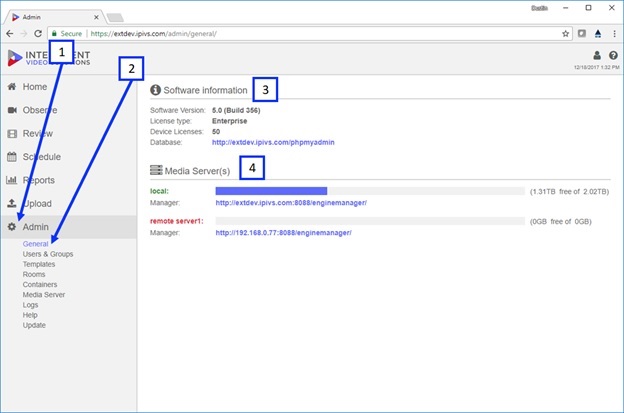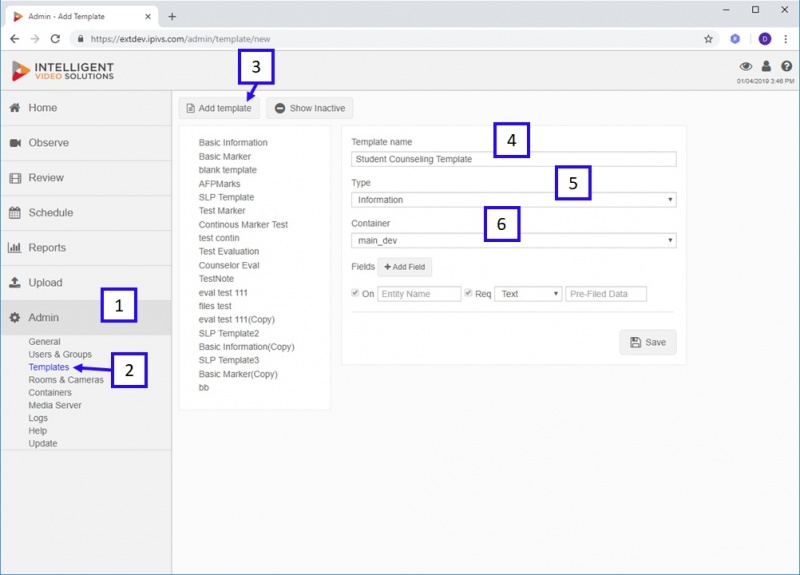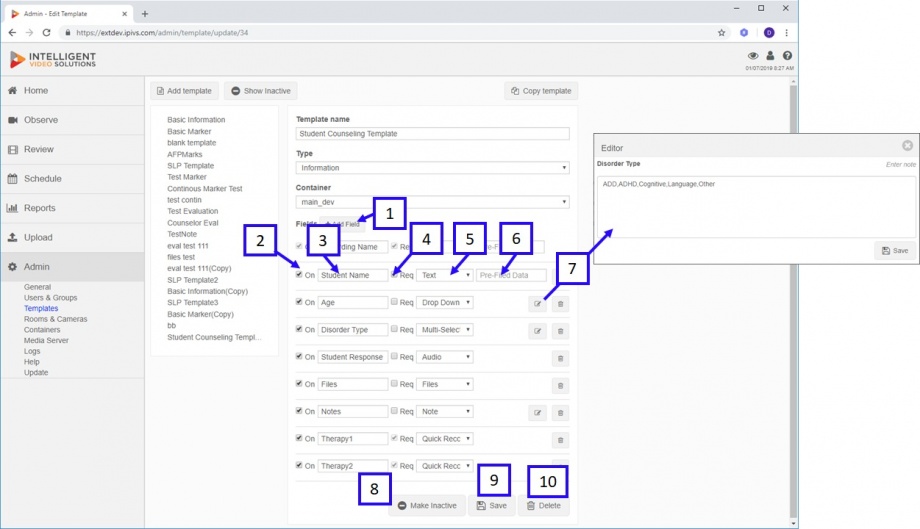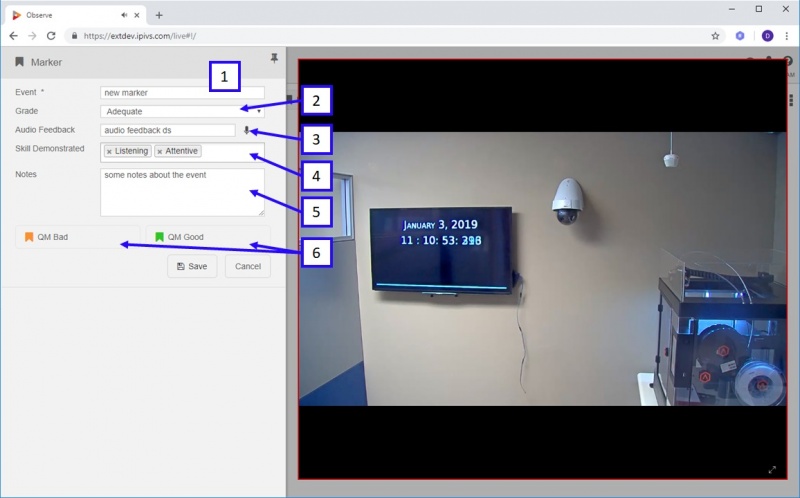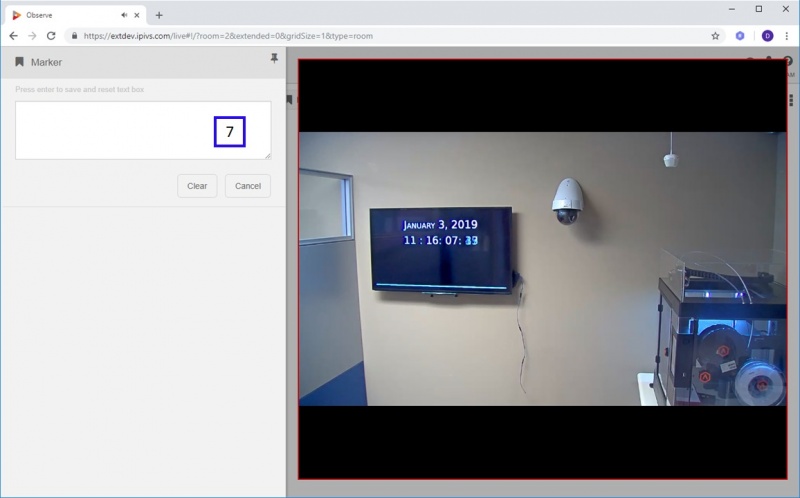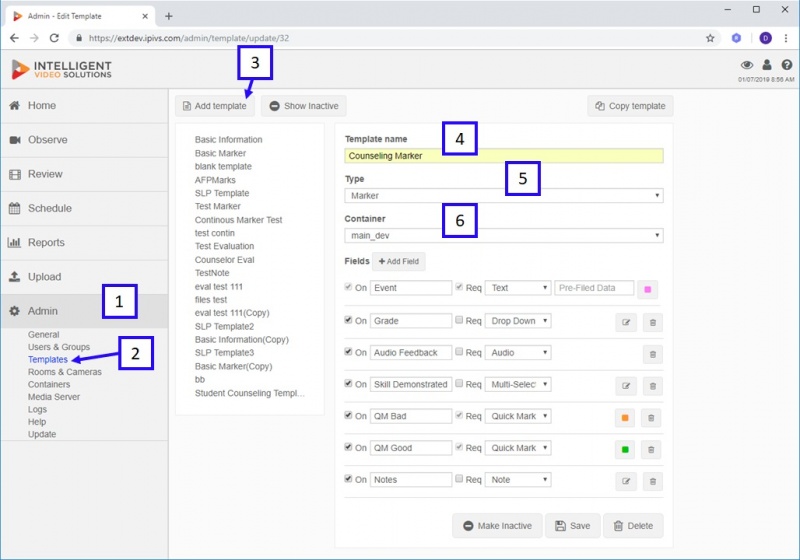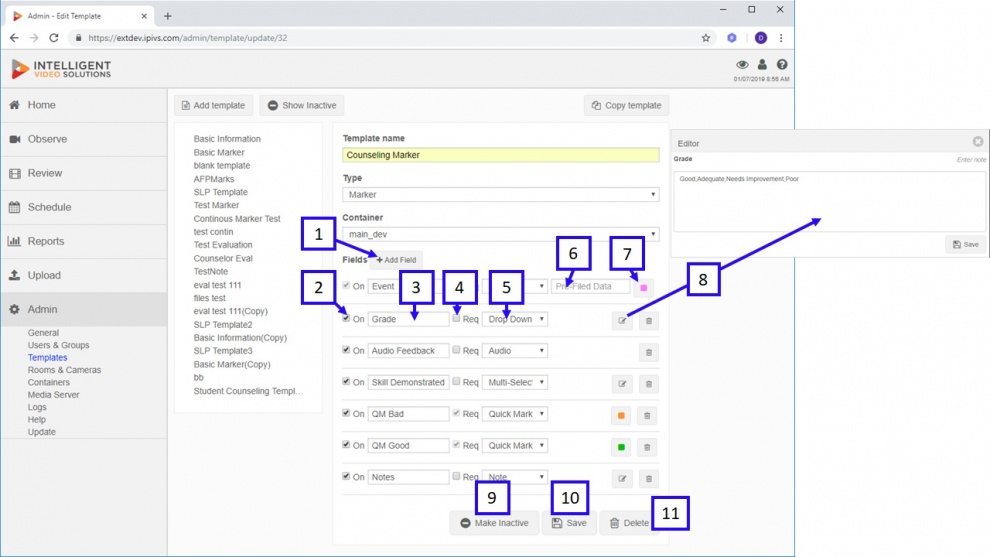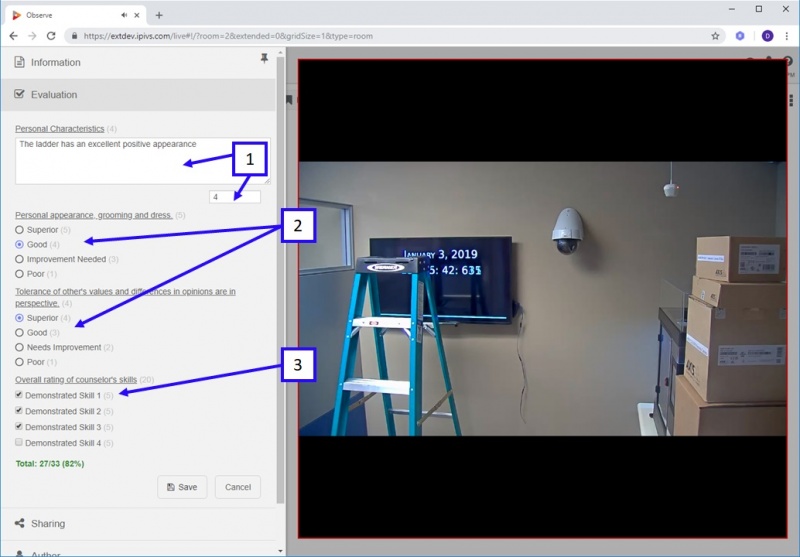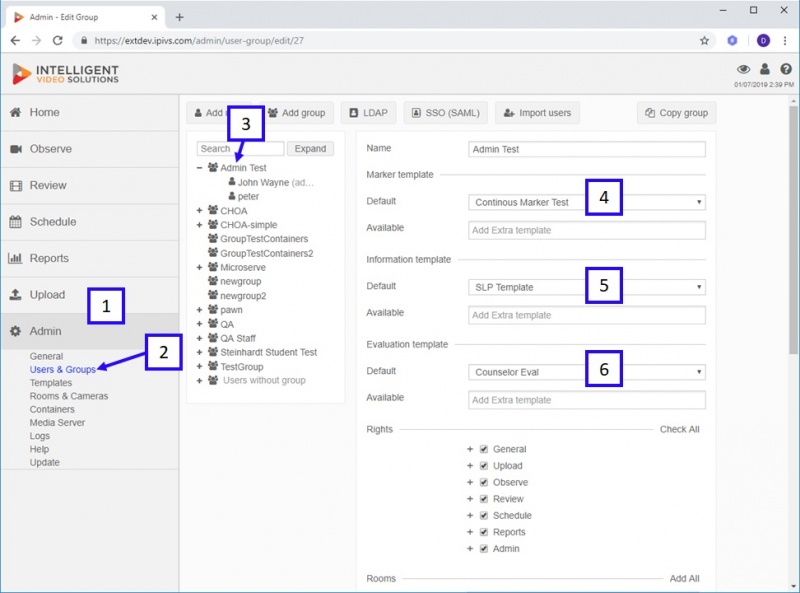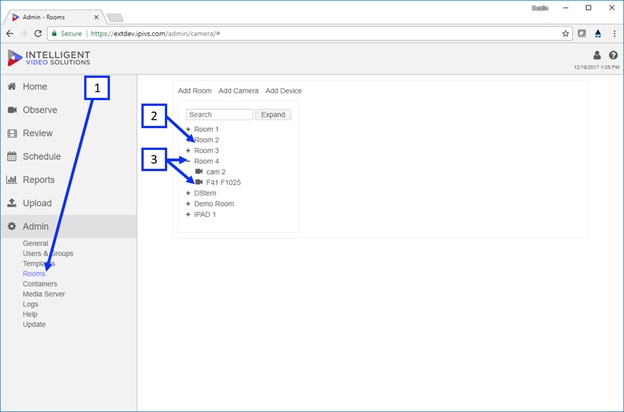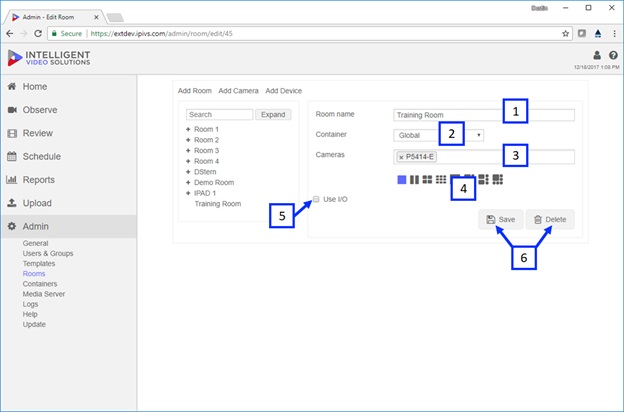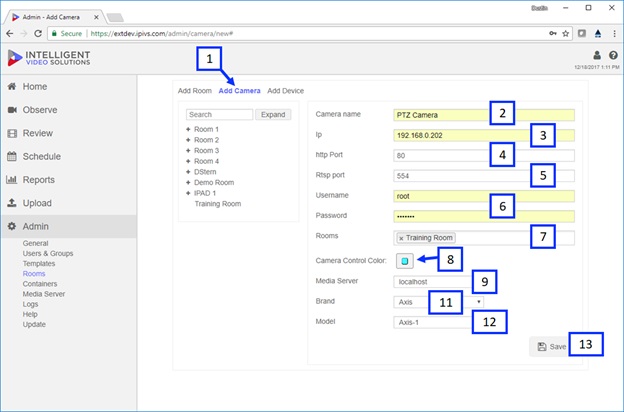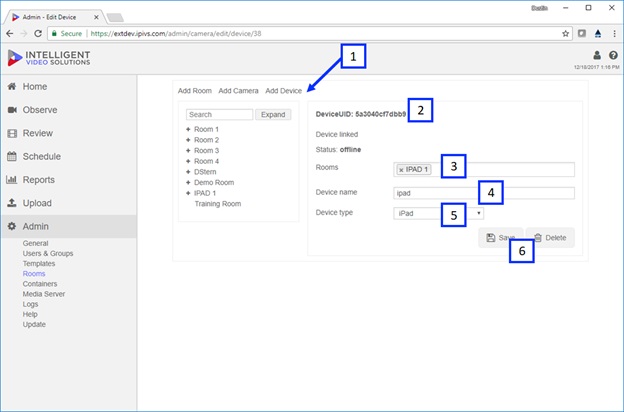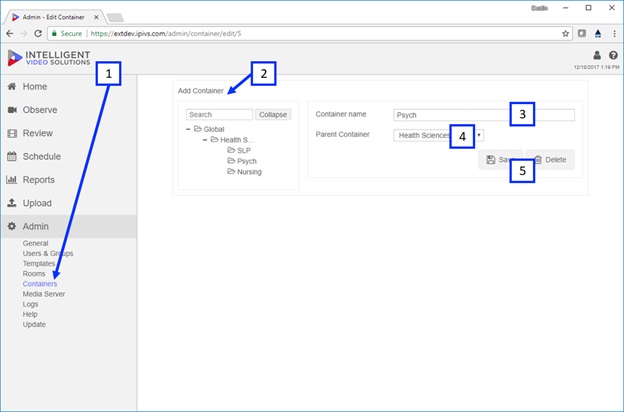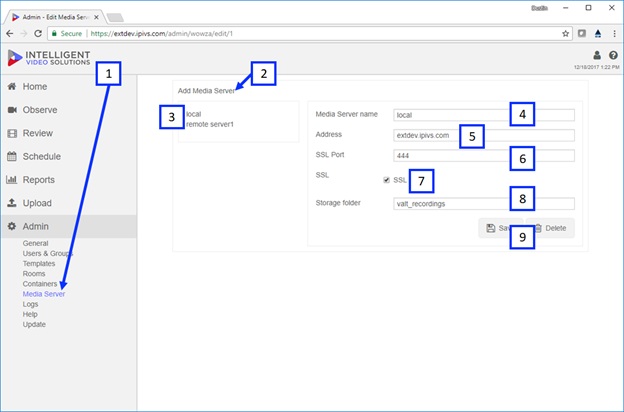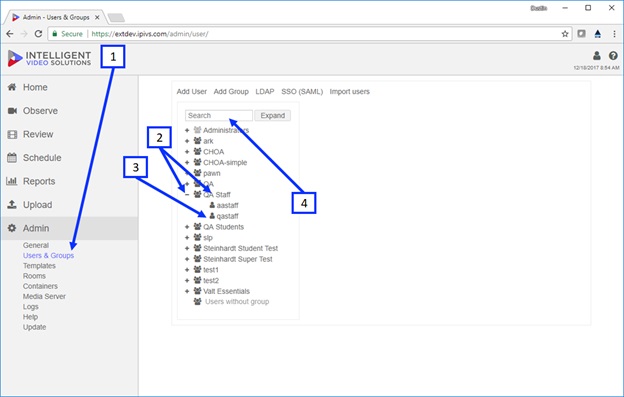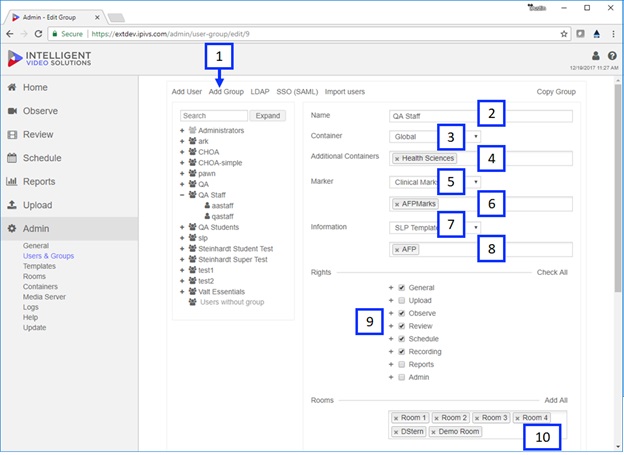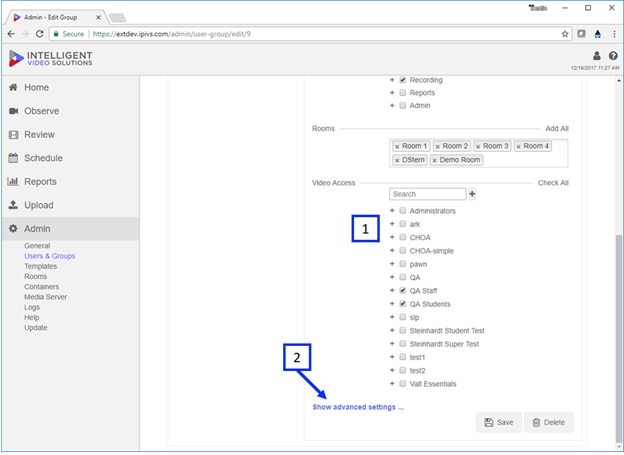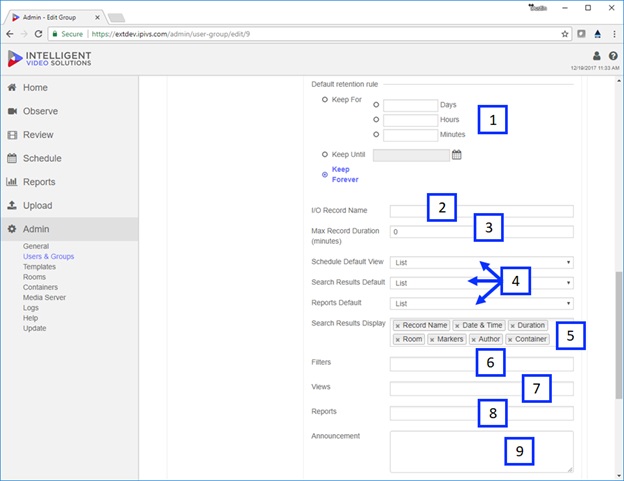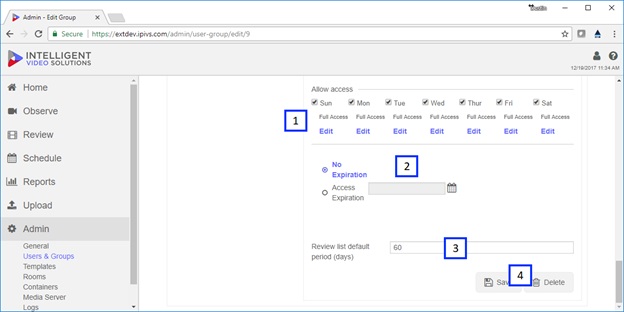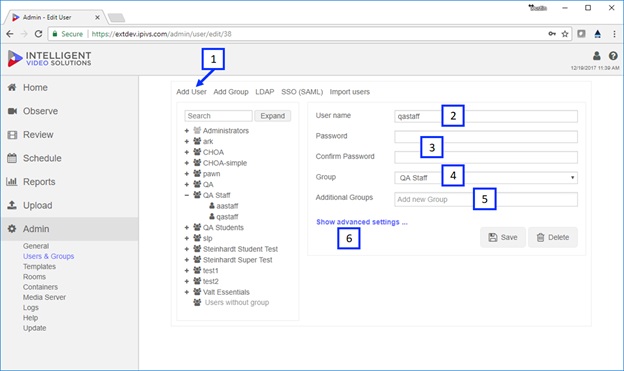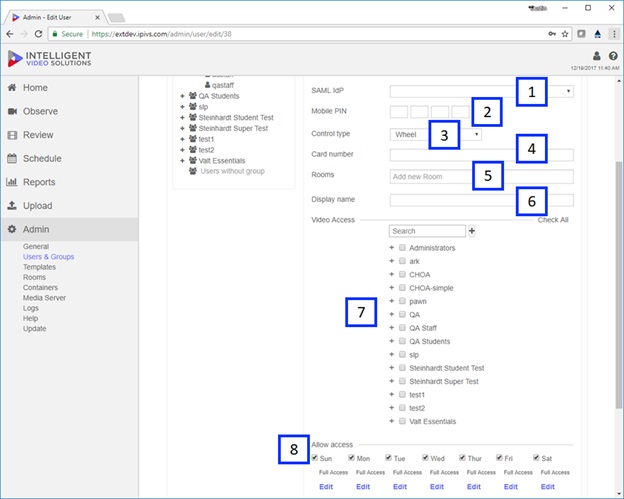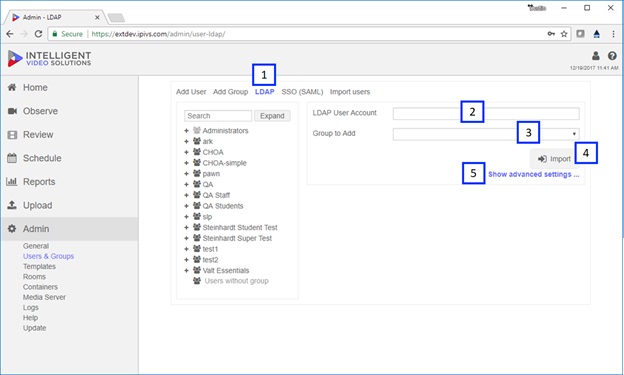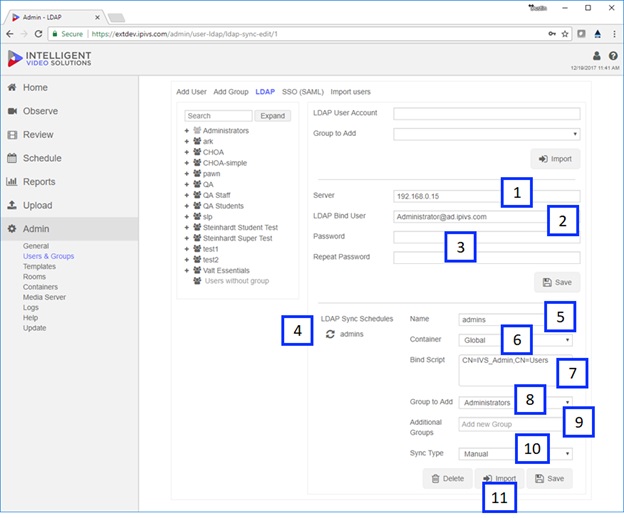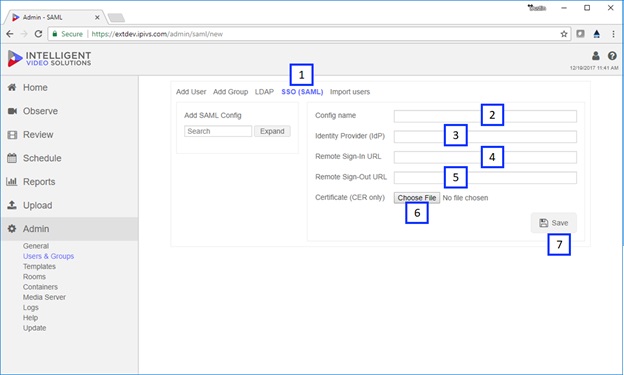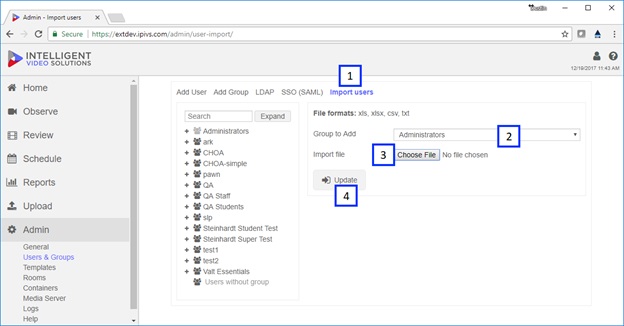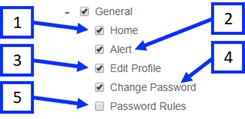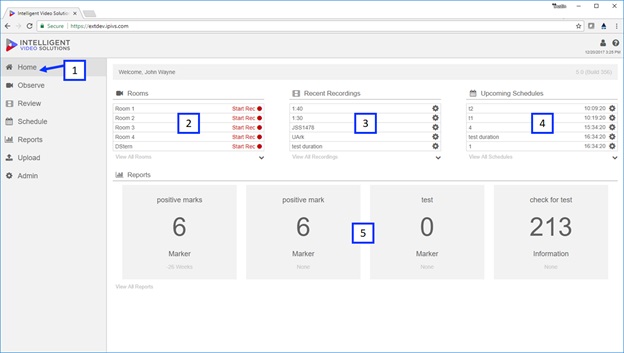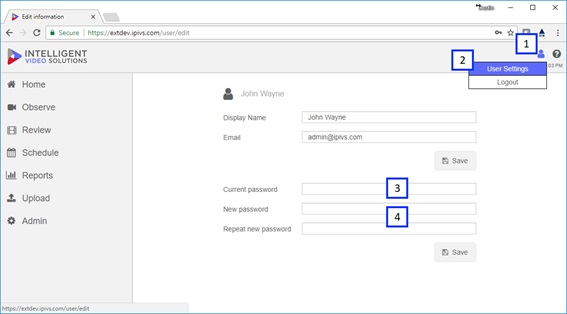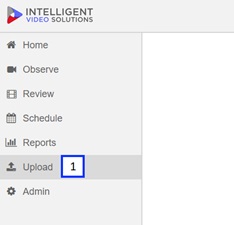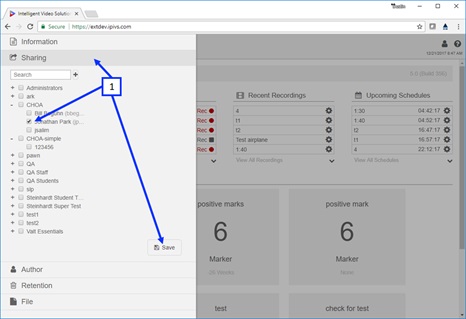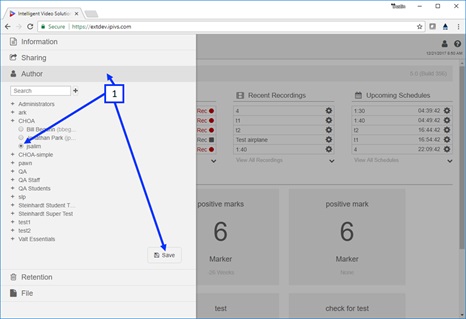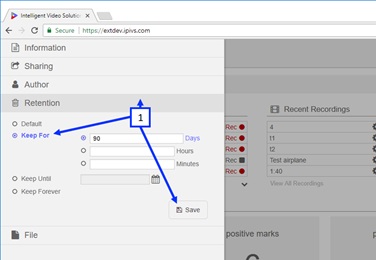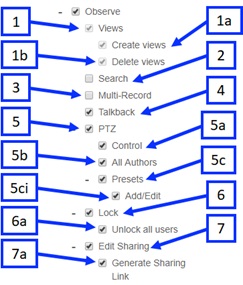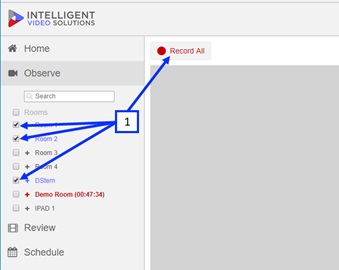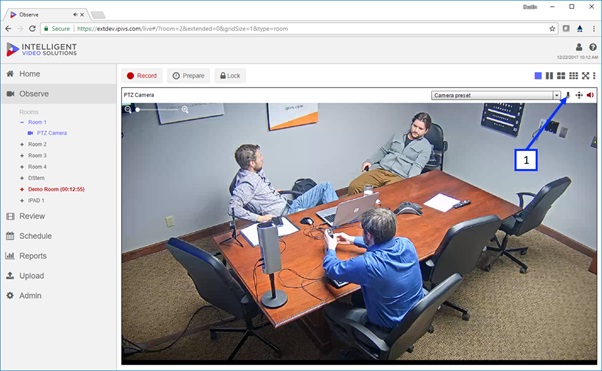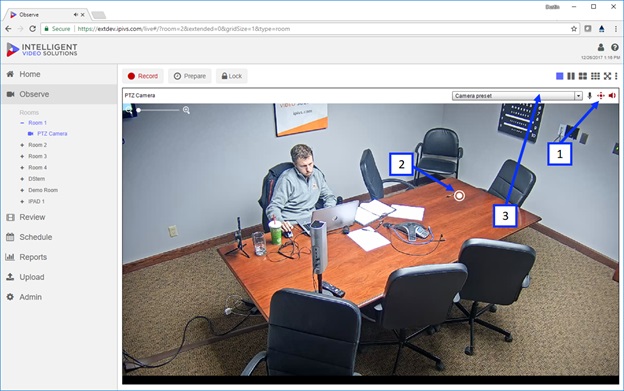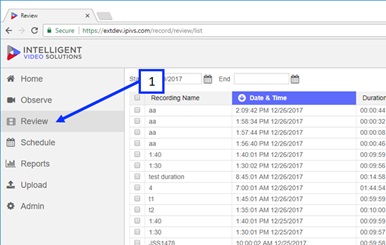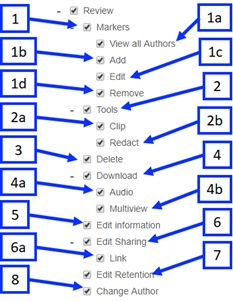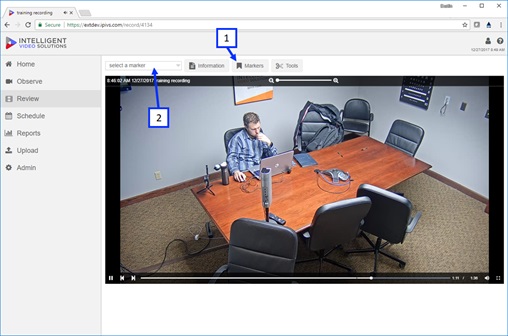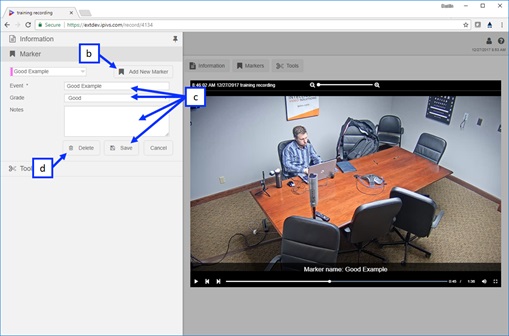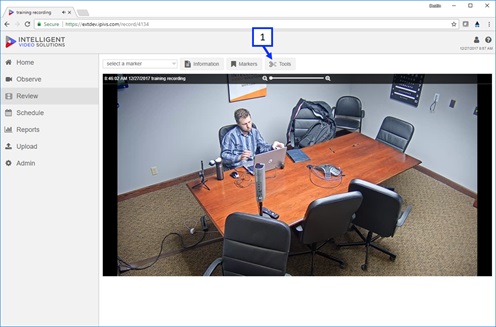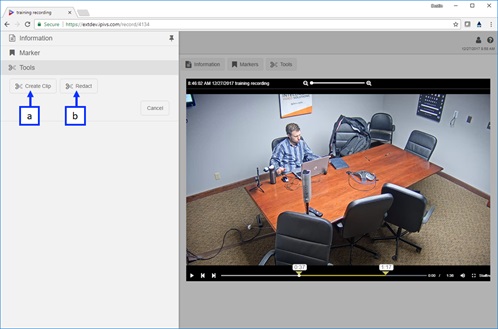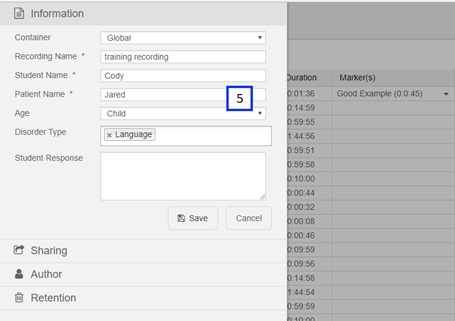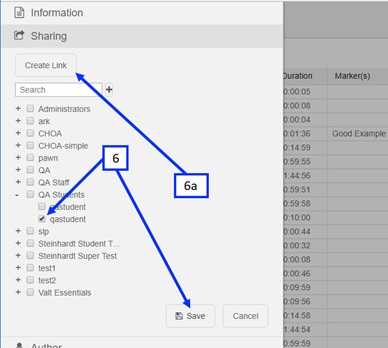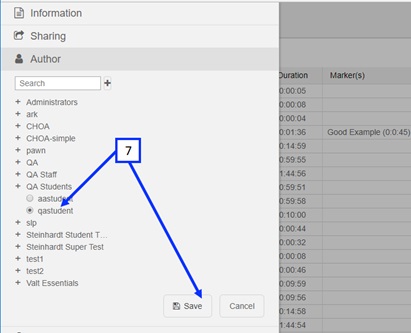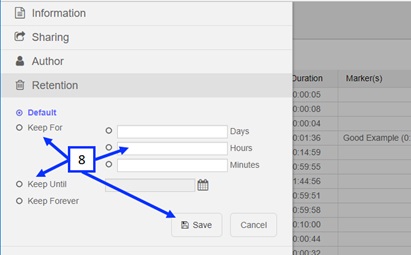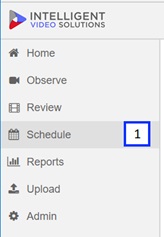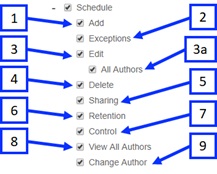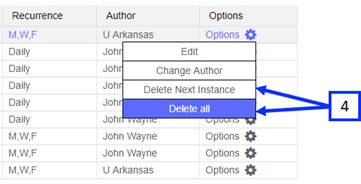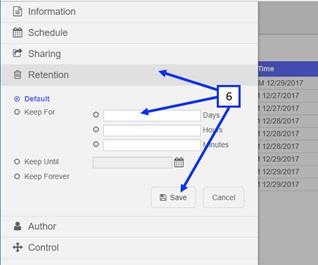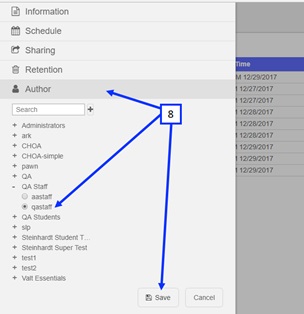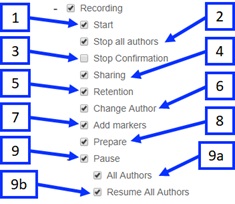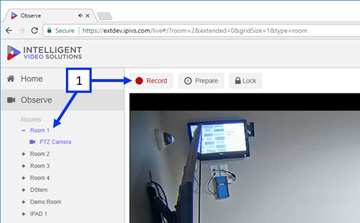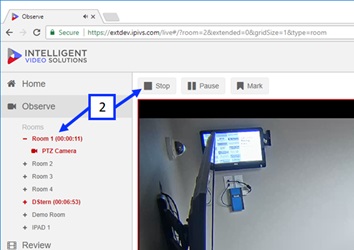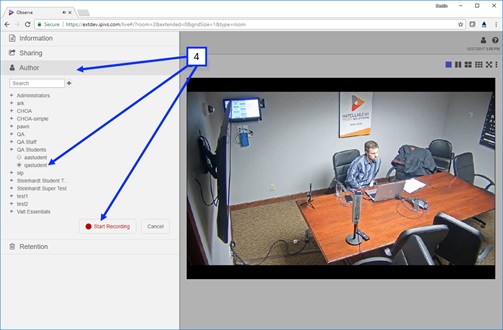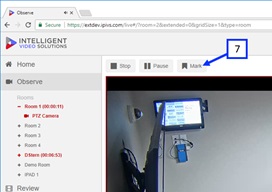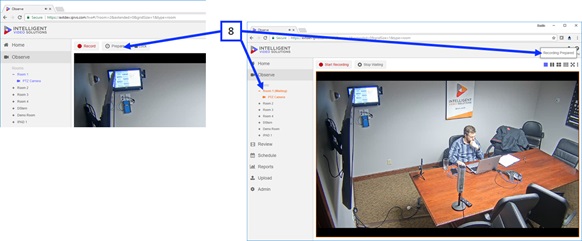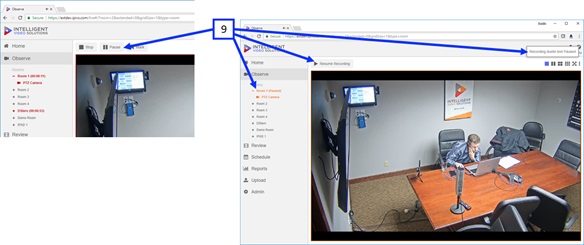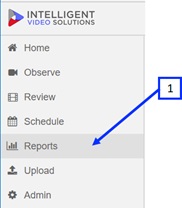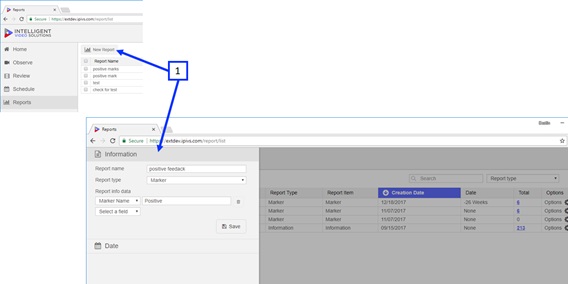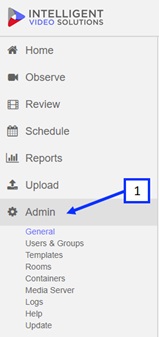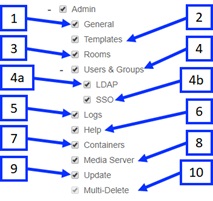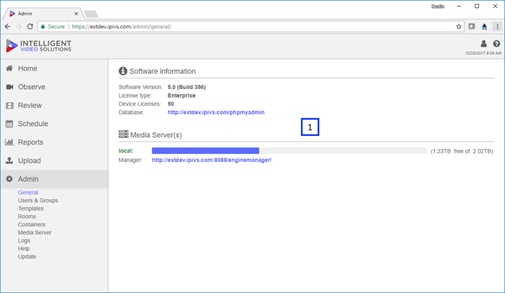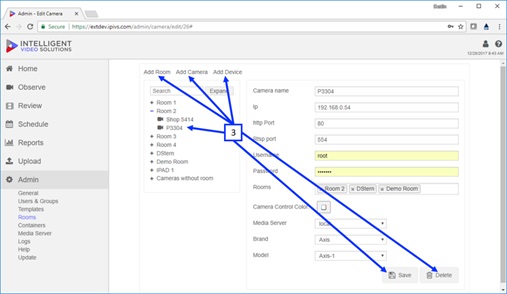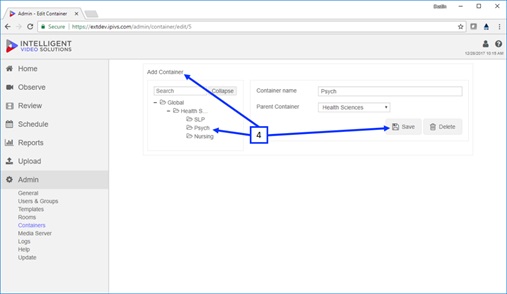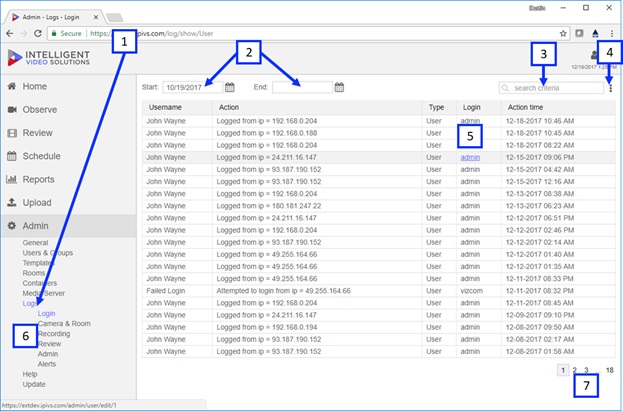VALT Administrator Guide 5.0
General
The general section under Admin provides a snapshot of the software along with some management links as shown below.
- ) Admin: if a user has administrative rights they will be able to click on the Admin section.
- ) General Link: the default section that will load once a user clicks on admin is General assuming they have access to this Admin section. The general system provides some basic application and system information.
- ) Software Information: this displays the software version, license type, number of licenses and a link to a database management tool (phpmyadmin).
- ) Global Settings: this allows a user to toggle settings that apply to all users. The date format and video streaming method for live observation.
- ) Email Settings: these are the connection settings to be used for email alerts.
- ) Media Server(s): this displays all the media servers associated with the software instance, the amount of storage used / remaining on each, and a management link for the video engine on each media server. Note if a media server is online it will have a green name, if it is offline the name will appear in red as shown above.
- ) Customization: this allows a user to customize the login page with alternative graphics and links.
Templates
Templates within VALT are used to tie searchable & reportable information to videos. A template(s) is assigned to a user group, where when that user starts or schedules a recording their set of templates will automatically get assigned to the associated recording(s). There are three types of templates listed below (Information, Marker, Evaluation). Each template type has a set of fields that can be used in the creation of the template. A template can consist of any number of fields and field types. These templates can be created and customized to meet a wide range of unique applications and workflows.
Information Templates
Information forms are typically used at the start of a recording to define information about that recording. Information templates can also be modified in the review section after a recording has been completed.
Information Field Types
When creating or modifying an information template there are a variety of field types that can be used. See below for reference.
1.) Text: This field is a freeform text box with a title. This field is limited to 128 characters.
2.) Files: This field adds a button to the template that allows users to upload any number of .pdf, docx, and xlsx files. These files generate links within the template that can be used to download the uploaded files.
3.) Quick Record: This field creates a titled clickable button on the information form. If a user clicks this button it titles the recording with the button name and bypasses // ignores all other fields.
4.) Drop Down: This field is a drop down list with a title. Any number of drop down options can be defined, but only a single one can be selected when a user is filling out the template.
5.) Multi-Select: This field is a searchable drop down list with a title. Any number of drop down options can be defined, and any number can be selected when a user is filling out this template.
6.) Audio: This field is freeform text box with a title that includes icons for recording an audio note. If a recorded audio note is present, the user will have the option to play it back or delete it using associated icons.
7.) Note: This field is a larger freeform text box with a title. This field is limited to 500 characters.
Creating a New Information Template
- ) Click the Admin button on the main navigation menu.
- ) Select Templates.
- ) Press Add Template.
- ) Enter a template name.
- ) Select the template type (Information).
- ) Select the container.
- ) The Add Field button is used to create new fields within the template as shown above. There is no limit to the number of fields you can associate with a single template.
- ) To enable a field within a template, the On checkbox must be checked.
- ) This dialog box is used to title the field.
- ) If the Req box is checked for the field it forces the user to input data into that field.
- ) This drop down box defines the field type.
- ) This dialog box can be set to pre-populate the template form with data for that field.
- ) This Edit button is used to launch the editor. This button appears for Drop Down, Multi-Select & Notes field types. For Drop Down & Multi-Select fields, it is used to define the user options within the form. This can be done by seperating each option with a comma as shown above. For the notes field, it can be used to pre-populate the data within the Notes text box field on the Information template form.
- ) This button deactivates the template so it is not shown and cannot be applied to user groups.
- ) This button saves the template.
- ) This button deletes the template, this button will only appear if there are no user groups using this template and if no recordings or schedules have been created using this template. If any of those conditions are true the only option to remove the template would be to deactivate (hide) the template.
Marker Templates
Markers are used to tie information to specific points in a recording. Markers can be added during a recording or after the fact when reviewing a video recording. Markers create key point within the video that allow users to easily jump right to that point within a longer video (much like chapters in a DVD). The data associated with a marker can be overlayed as text on the video during playback.
Marker Field Types
1.) Text: This field is a freeform text box with a title. This field is limited to 128 characters.
2.) Drop Down: This field is a dropdown list with a title. Any number of drop down options can be defined but only a single one can be selected when a user is filling out the marker form.
3.) Audio: This field is freeform text box with a title that includes icons for recording an audio note. If a recorded audio note is present, the user will have the option to play it back or delete it using associated icons.
4.) Multi-Select: This field is a searchable drop down list with a title. Any number of drop down options can be defined, and any number can be selected when a user is filling out this template.
5.) Note: This field is a larger freeform text box with a title. This field is limited to 500 characters.
6.) Quick Mark: This field creates a titled clickable button on the marker form. If a user clicks this button, it inserts a marker and titles the marker with the button this action bypasses // ignores all other fields.
7.) Continous Marker: This field is only available as the first field within the marker template. Changing to this changes the formatting of the marker. When the mark button is pressed it brings up the form as shown below and changes the behavior. To insert a marker a user can now simply type and press enter. The marker is always inserted when they begin to type. This method is generally used when the workflow requires that many markers are being inserted.
Creating a New Marker Template
- ) Click the Admin button on the main navigation menu.
- ) Select Templates.
- ) Press Add Template.
- ) Enter a template name.
- ) Select the template type (Information).
- ) Select the container.
- ) The Add Field button is used to create new fields within the template as shown above. There is no limit to the number of fields you can associate with a single template.
- ) To enable a field within a template form the On checkbox must be checked.
- ) This dialog box is used to title the field.
- ) If the Req box is checked for the field it forces the user to input data into that field.
- ) This drop down box defines the field type.
- ) This dialog box can be set to pre-populate the template form with data for that field.
- ) This button is used to define the marker color that shows up on the timeline when a marker is inserted.
- ) This Edit button is used to launch the editor. This button appears for Drop Down, Multi-Select & Notes field types. For Drop Down & Multi-Select fields, it is used to define the user options within the form. This can be done by seperating each option with a comma as shown above. For the notes field, it can be used to pre-populate the data within the notes text box field on the information template form.
- ) This button deactivates the template so it is not shown and cannot be applied to user groups.
- ) This button saves the template.
- ) This button deletes the template and will only appear if there are no user groups using this template, and if no recordings or schedules have been created using this template. If any of those conditions are true, the only option to remove the template would be to deactivate (hide) the template.
Evaluation Templates
Evaluation templates are typically used during a recording, or after a recording is completed. An evaluation form acts much like an information form in that it is used to tie a single set of information into the recording. The big difference between an evaluation and information form is that numeric values can be assigned to the fields within an evaluation form. This allows scoring to be done on each item and the overall form. Evaluation also allow unique reports to be run against them that are based on score %.
Evaluation Template Fields
When creating or modifying an evaluation template, there are a variety of field types that can be used. See below for reference.
1.) Description: This field is a larger freeform text box with a question. This field is limited to 500 characters and allows the numerical value or score to be entered in the box below.
2.) Single select: This field consists of radio button(s) each with a description and associated score. This field type allows a user to select a single option as shown below.
3.) Multi Checkbox: This field consists of checkboxes each with a description and associated score. This field type allows a user to select multiple boxes as shown below.
Creating a New Evaluation Template
Assigning a Template
Templates are always assigned to user groups, with the individual users then being added to the user groups.
- ) Click the Admin button on the main navigation menu.
- ) Select Users & Groups.
- ) Click on the user group.
- ) Select a default marker template using the drop down menu, and additional marker templates can be added in the dialog box below allowing the user(s) to select a different template to be used for a specific recording or schedule.
- ) Select a default information template using the drop down menu, and additional information templates can be added in the dialog box below allowing the user(s) to select a different template to be used for a specific recording or schedule.
- ) Select a default evaluation template using the drop down menu, and additional evaluation templates can be added in the dialog box below allowing the user(s) to select a different template to be used for a specific recorded video.
Rooms
Rooms act as containers for a camera or group of cameras. Rooms can be recorded using a contact closure / card reader, schedule, or on demand through the user interface. Rooms are also assignable from a user permission perspective.
- ) Clicking on the Rooms link under Admin will take you to the section displayed above.
- ) Clicking on a room name will allow a user to edit the room name / settings.
- ) Expanding a room will reveal the camera(s) associated with a room, while clicking on a camera will allow a user to edit the camera name / settings.
Clicking on a room name or clicking Add Room will pull up the room settings as shown below.
- ) Room Name: a room name can be entered here. This name will be the identifier that will be used throughout the rest of the system.
- ) Container: this specifies the container the template will use. Users are only able to see objects that are in the same container or a sub container.
- ) Cameras: this is used to associate cameras to a room.
- ) View Type: this can be used to define a view type default for the room, if no option is selected the system will automatically use the assumed best fit view type for the number of cameras.
- ) Use I/O: this checkbox should be checked if you are using a push button to start / stop recordings. When this is checked a sub menu with options will appear.
- ) Save / Delete: Once a room is configured pressing Save will save the changes.
Clicking on a camera name or clicking Add Camera will pull up the camera settings shown below.
- ) Add Camera: to add a new camera click the Add Camera button, if the system has available device licenses available a menu will pop up as shown above.
- ) Camera Name: this is a label that can be assigned to the camera, this name will be used throughout the rest of the system.
- ) IP: the DNS name or IP address of the camera should be entered here.
- ) HTTP Port: this is the port that will be used to authenticate to the camera (note: the default should be 80 unless changed within the camera).
- ) RTSP Port: this is the port that will be used to stream video between the camera and server (note: the default should be 554 unless changed within the camera).
- ) Username / Password: enter a admin username and password for the camera.
- ) Rooms: this can be used to assign the camera to room(s).
- ) Camera Control Color: the control color can be changed using this color picker. Controls are overlaid on top of the video when enabled and include digital zoom and PTZ.
- ) Media Server: this option is used to define what server the camera is connected to.
- ) Brand: this drop down specifies what camera type is being used.
- ) Model: this drop down specifies what model camera is being used.
- ) Save: once the camera settings are set pressing Save will commit the settings / changes.
Clicking on a camera name or clicking Add Device will pull up the device settings shown below.
- ) Add Device: to add a new device click the Add Device button, if the system has available device licenses available a menu will pop up as shown above.
- ) Device UID: if an iPhone / iPad is being added the device UID will need to be entered on the client side as documented here: http://ipivs.com/wiki/Installing_Mobile_Devices
- ) Rooms: this is used to add the device to room(s).
- ) Device Name: this is a label that can be assigned to the device. This name will be used throughout the rest of the system.
- ) Device Type: this is used to define the type of device.
- ) Save / Delete: make sure to click Save after settings are changed to commit the changes.
Containers
Containers are used to segment objects. A user is only able to see objects (rooms, templates, user groups) in their container or a sub container. Containers are typically implemented when multiple departments with administrator(s) of each department are sharing a single software instance.
- ) Clicking on the Containers link under Admin will take you to the section displayed above.
- ) Add Container: clicking on Add Container brings up the menu shown on the right above.
- ) Container Name: this is the container identifier for the container throughout the rest of the system.
- ) Parent Container: users have access to sub containers but not parent containers. To place a container under another use the Parent Container drop down menu.
- ) Save / Delete: Once a container is configured click Save to commit the changes.
Media Server
Media servers are used to stream video / connect to cameras and store video.
- ) Clicking on the Media Server link under Admin will take you to the section displayed above.
- ) Add Media Server: clicking on Add Container brings up the menu shown on the right above.
- ) This lists all the existing media servers configured for the software instance.
- ) Media Server Name: this is an identifier used throughout the system.
- ) Address: the IP address or DNS name of the server.
- ) SSL Port: if encrypted video is desired this designates the default port used (note: 444 is the default unless otherwise specified within configuration files and server firewall).
- ) SSL: this checkbox enables video encryption.
- ) Storage Folder: this designates the folder name that the video will be stored in (note: default is valt_recordings unless otherwise specified).
Users & Groups
The User and Groups section is where all the user management is done and where all the permissions are set up.
- ) Clicking on the Users & Groups link under Admin will take you to the section displayed above.
- ) Clicking on a group name will pull up the groups settings, clicking on the + next to a group will expand the group and reveal all the users associated with that group.
- ) Clicking on a user name will pull up the user settings.
- ) The search box can be used to quickly find a user or group
Group Management
- ) Clicking on Add Group pulls up the group section on the right shown above.
- ) Group Name: this is used as an identifier for the group.
- ) Container: this specifies the container the user group will use. Users are only able to see objects that are in the same container or a sub container.
- ) Additional Containers: this is used to specify additional containers, any users within a group that has multiple containers would be able to see objects within both.
- ) Marker Template: this specifies the default marker template users within this group will use.
- ) Additional Marker Templates: this is used to specify additional marker templates, the additional templates will show up in a drop down that can be selected when a user clicks the mark button.
- ) Information Template: this specifies the default information template users within this group will use.
- ) Additional Information Templates: this is used to specify additional information templates, the additional templates will show up in a drop down that can be selected when a user clicks the record / schedule button.
- ) Rights: this section is used to designate what a user can do within the software, clicking the + next to any of the sections will reveal all the sub-rights.
- ) Rooms: this is used to assign access to rooms for users within the group. This access applies to both live and recorded video.
- ) Video Access: this section defines what videos users within this group have access to based on who authored the recordings. This applies to both live observation and review.
- ) Show Advanced Settings: clicking this link will expose additional user group settings.
- ) Retention Rule: this is used to define how long recordings are kept on the system before they are automatically deleted. Changing this setting will retroactively affect existing recordings.
- ) I/O Record Name: if a user within this user group is configured to author a recordings started or stopped using a button this setting will create the default recording name for those recordings.
- ) Max Record Duration: this setting defines the maximum record length before a recording is automatically stopped.
- ) Default Views: for sections that offer different view layouts (list vs. thumbnail) the default preference for users within this group can be set here.
- ) Search Results Display: this is used to set the columns / information that is displayed at the top level when looking at the search results within the review section.
- ) Filters: filters are user specific by default but a filter (advanced search query) can be shared across a user group using this setting.
- ) Views: views are user specific by default but a view (custom camera layout) can be shared across a user group using this setting.
- ) Reports: reports are user specific by default but a report can be shared across a user group using this setting.
- ) Announcement: anything entered in this field will show up in the home screen under announcements for the users within the user group.
- ) Allow Access: this section can be used to restrict users to only be able to use the system during certain days or even certain times within certain days.
- ) Expiration Date: this can be used to remove access to the system for all users within the group on a certain date.
- ) Review list Default: this is the default number of days that are pulled up in the search query when a user within the group clicks the review button. The user can go back further to find older videos by adjusting the date range.
- ) Clicking on Add User pulls up the user section on the right shown above.
- ) User Name: to create a local user account enter a user name.
- ) Password / Confirm: assign the user a password.
- ) Group: this specified the user group the user will be a part of.
- ) Additional Groups: this is used if the user will be a part of more than a single group. From a rights and video access perspective, the settings within both groups will be merged.
- ) Show Advanced Settings: clicking this link will reveal additional user settings.
- ) SAML IDP: this auto populates when an SSO / SAML user is imported and defines the IDP to be used to authenticate this user against.
- ) Mobile Pin: this is used in conjunction with our BEAM application and provides a pin code that is associated with the user account for use with BEAM.
- ) Control Type: this is used to change the PTZ control type for a user.
- ) Card Number: this is used in conjunction with card reader(s) so the system knows what card number should be associated with a user.
- ) Rooms: you can use this section to grant access to rooms, these would be in addition to what the user already has access to based on their user group.
- ) Display Name: this can be used so a different identifier is used throughout the system other than the actual account name.
- ) Video Access: this section is used to grant access to live / recorded video based on who authored it for the user, this is in addition to what they already have access to based on their user group.
- ) Allow Access: this section is used to grant / restrict access to the system during certain times / days. This setting would be in addition to what is set on the group level.
LDAP Management
- ) Clicking on LDAP pulls up the user section on the right shown above.
- ) LDAP User Account: this can be used to import a single LDAP user, you will need to enter the full DN of the user account excluding the DC information. Example: CN=dstern,OU=Users
- ) Group to Add: this drop down menu is used to specify the group the LDAP user will be imported into.
- ) Import Button: clicking this will query LDAP and import the specified user.
- ) Server: used to point to LDAP server / cluster using either the IP address or DNS name.
- ) LDAP Bind User: this is the account that will be used to bind / query LDAP.
- ) LDAP Bind Password: once the server, bind user, and password are entered pressing Save should result in a connected message.
- ) LDAP Sync Schedules: clicking on an existing sync schedule will pull the settings up on the right as shown. If no sync schedule is selected the settings will be blank.
- ) Name: this is an identifier for the sync schedule.
- ) Container: this drop down menu is used to specify a container for the sync schedule (this does not affect the imported users but just the sync schedule object).
- ) Bind Script: this is can be pointed to an OU or security group, the sync schedule will pull in all the matching user accounts. Example: CN=IVS_Admins,OU=User_Groups
- ) Group to Add: the users that match the bind script will be placed into this group automatically.
- ) Additional Groups: users that match the bind script will be placed into these groups as well.
- ) Sync Type: the sync can be set to Automatic or Manual. The automatic interval can be adjusted to any duration but is set to 24 hours by default.
- ) Import: this button is used to execute the sync and bring in the matching LDAP user accounts.
SSO Configuration
- ) Clicking on SSO (SAML) pulls up the section on the right shown above.
- ) Config Name: this is used as the IDP identifier
- ) Identity Provider: this is the IP address / identity provider url.
- ) Remote Sign-In URL: the remote sign-in URL of your IDP. Example: https://<adfs-server>/adfs/ls/
- ) Remote Sign-Out URL: the remote sign-in URL of your IDP. Example: https://<adfs-server>/adfs/ls/?wa=wsignout1.0
- ) Certificate: used to upload created certificate.
Import Users
- ) Clicking Import Users pulls up the section on the right shown above
- ) Group to Add: this drop down menu defines the user group the imported users will be associated with.
- ) Chose File: this button allows a user to browse to the file that contains the user data to be imported.
- ) Update: this button executes the import.
User Rights
The Valt system has a detailed user rights management system: almost every feature / function can be enabled or disabled based on requirements. Below is a list of the rights and an explanation on how each translates to the application.
General
This includes general settings most of which apply to the application overall.
General Rights:
- 1.) Home (1): this grants access to the home section of the application. The home section provides a dashboard of sections / objects that a user has access to. These include rooms (2), recent recordings (3), schedules (4) and reports (5) as shown below. If this right is unchecked this entire section is hidden from the UI, what parts of the home screen display depend on the other rights the user has.
- 2.) Alerts (1): if the alerts right is checked anytime an alert occurs the alert ribbon will pop up in the UI as shown below. Alerts will continue to display until someone acknowledges (2) them. Alerts include camera offline / online, media server offline / online, low disk space and other application health related items.
- 3.) Edit Profile: this right allows a user to edit the Display Name (3) and Email (4) associated with their user account. Clicking on the User icon (1) then navigating to User Settings (2) reveals these options as shown below.
- 4.) Change Password: This right allows a user to the password associated with the account by entering the current password (3) and new password (4). Clicking on the User icon (1) then navigating to User Settings (2) reveals these options as shown below.
- Password Rules: if this is enabled it will enforce password standards for local user accounts within the group. Those standards include: 10 failures = 3 min lockout, password complexity (3 of 4 uppercase, lowercase, number symbol), password history = cannot use last 3 passwords and password expiration = 180 days.
Upload
This right allows users to upload supported video formats to the Valt system. The uploaded videos can be tagged with information and markers just like video created using Valt. If the upload right is checked the Upload button will show up on the main navigation pane as shown below.
Upload Rights:
- 1.) Sharing: When a user clicks the upload button if they have the sharing right the sharing button (1) will appear as shown below. Users can use this to share the uploaded video with users that normally would not have access to it.
- 2.) Author: When a user clicks the upload button if they have the author right the author button (1) will appear as shown below. Users can use this to change the author of the uploaded video this can be important as access to the video is based on who authored it.
- 3.) Retention: When a user clicks the Upload button, if they have the retention right the Retention button (1) will appear as shown below. Users can use this to change the length of time the video will be stored on the system for before it is automatically deleted.
Observe
If the observe right is checked, the Observe button (1) will show up in the main navigation pane as shown below. The observe section is where live observation and camera control can be done within the application.
Observe Rights:
- 1.) Views: will be available in 5.1
- 1.) a.) Create Views: will be available in 5.1
- 1.) b.) Delete Views: will be available in 5.1
- 2.) Search: the search right enables a search dialog box (1) that can be used to filter the rooms / cameras displayed within observe.
- 3.) Multi-Record: the Multi-Record feature (1) allows a user to start or stop recording on multiple rooms at the same time. If this right is enabled the user will see a checkbox to the left of each room name, clicking on the checkbox will select the room and a Record All button will appear as shown below.
- 4.) Talkback: Clicking on a camera under observe will reveal the camera toolbar. If a user has the talkback right the Microphone icon (1) will appear on the toolbar. Clicking the Microphone icon will allow the user to talk back into the room through the camera output using a standard headset / computer microphone.
- 5.) PTZ: this right allows users to control a PTZ capable camera.
- 5.) a.) Control: clicking on a camera under observe will reveal the camera toolbar. If a user has the control right and the camera is PTZ capable the PTZ icon (1) will appear on the toolbar. Clicking the PTZ icon converts the mouse to a target (2) or display a directional arrow pad (depending on user settings). This can be used to move the camera around or zoom in / out.
- 5.) b.) All Authors: this right allows a user to control PTZ cameras for other users recordings (only if the user has access to them).
- 5.) c.) Presets: if the presets right is checked the preset dropdown menu (3) will appear as shown below. A user can select from any of the existing presets to reposition the camera.
- 5.) c.) i.) Add / Delete: this right allows users to create new and delete existing presets.
- 6.) Lock: the lock feature disables all live observation of video / audio, and prevents recordings from being started on the locked room. If a user has the lock right enabled if they click on a room that does not have an active recording the Lock button (1) will appear as shown below.
- 6.) a.) Unlock all Users: if a user has the lock right they will be able to unlock (2) rooms that they locked. If they have the unlock all users right they will be able to unlock any room that they have access to regardless of who locked it.
- 7.) Edit Sharing: the sharing feature allows a user to share the video with any user group or individual user that would normally not have access to the video. The sharing will apply both to live observation (assuming the other user / user group has access to the given room) and for recorded video under the review section (regardless of room access).
- 7.) a.) Generate Sharing Link: this right allows a user to generate a direct link that can be copied to a clipboard and distributed via email or other means. This direct link would allow access to the live session for the duration of the recording regardless of rights or if they even had a software login.
Review
If the review right is checked the Review button (1) will show up in the main navigation pane as shown below. The review section is where video playback and video management can be done.
Review Rights:
- 1.) Markers: markers are used to tag specific events within a recording. If the marker right is unchecked, the Marker button (1) will not be displayed. If the recording contains markers, the marker drop down menu (2) will also only be displayed if a user has the marker right.
- 1.) a.) View All Authors: this right allows the user to view other authors markers. If this is unchecked the user will only be able to see markers that they created.
- 1.) b.) Add: if this right is checked, the user will have the ability to add new markers during playback.
- 1.) c.) Edit: this right allows a user to edit existing markers during playback.
- 1.) d.) Remove: this right allows a user to delete existing markers during playback.
- 2.) Tools: the tools right enables some simple video editing tools. If a user has access to this right, the Tools button will show up when reviewing a recording as shown below.
- 2.) a.) Clip: this right allows a user to create smaller clips from recordings. This will create a new copy of the clip and will not augment the original recording in any way.
- 2.) b.) Redact: this right allows a user to remove sections from the video. This will create a new copy of the redacted recording and will not augment the original in any way.
Options:
- 3.) Delete: this right allows a user to delete recordings they have access to when in the review section as shown below.
- 4.) Download: this right allows a user to download recordings they have access to as shown below.
- 4.) a.) Audio: this right allows users to create an audio only copy (.mp3) of a recording and download it as shown below.
- 4.) b.) Multiview: this right allows users to create a single mp4 file from a recording that has multiple cameras associated with it. This feature will only be available for recordings with 2-4 cameras associated with them.
- 5.) Edit Information: clicking on Options -> Information will bring up the information modal as shown below. If a user has the edit information right, they will be able to modify existing information associated with the recording.
- 6.) Sharing: if a user has the sharing right they will be able to click on Options -> Sharing, this will bring up the sharing modal as shown below. Sharing allows a user to share a recording with a user or user group that would normally not have access to the video.
- 6.) a.) Create Link: if a user has the create link right the button will be available under the sharing modal as shown below. This button creates a unique link that allows any user with access to the server to browse directly to that recording using the unique link. The link bypasses the login page so even users without accounts can access a recording using the link.
- 7.) Change Author: if a user has the change author right they will be able to click on Options -> Change Author, this will bring up the modal as shown below. This allows a user to change the author of a recording. It is important to note that access to videos in the system is determined by who authored the recording. Changing the author will likely change who can access the video.
- 8.) Retention: if a user has the retention right they will be able to click on Options -> Retention, this will bring up the modal as shown below. This allows a user to change the period of time a recording is stored for before the system automatically deletes it. If Default is selected the rule will follow whatever is set at the user group level of the author of the recording.
Schedule
The Schedule section is used to set up recordings ahead of time. Users have the option to create repeating schedules. If this right is enabled the Schedule button (1) will show up under the main navigation menu as shown below.
Schedule Rights:
- 1.) Add: this right gives the user access to create new schedules. If this is checked when a user goes to the schedule section the New Schedule button will be available as shown below.
- 2.) Exceptions: the exception right is used to create dates where no schedules will start / stop. This is typically for holidays so recurring schedules do not automatically record. If a user has this right the Exception button will show up under the Schedule section as shown below.
Options:
- 3.) Edit: this right allows a user to edit the room, information, start / stop times and recurrence associated with any schedule they have access to view.
- 4.) Delete: this right allows a user to delete either the next instance of a recurring schedule or the entire schedule.
- 5.) Sharing: this right allows a user to share any recording created by the selected schedule to users or user groups that would normally not have access to them.
- 6.) Retention: this right allows a user to edit the retention period (length video is stored on the system before automatically deleted) for every video that is created by the selected schedule.
- 7.) Control: this right allows a user to move any PTZ capable camera to a preset at the beginning of a schedule.
- 8.) View All Authors: this right allows a user to see other users’ schedules. If this is unchecked the user will only be able to view schedules they created.
- 9.) Change Author: this right allows a user to change the author of a schedule and all recordings created by the selected schedule.
Recording
When a user is in the Observe section they are able to kick off ad-hoc recordings by selecting a room then pressing the record button.
Recording Rights:
- 1.) Start: this right allows the user to start recordings from the Observe section as shown below. After an available room is selected, the Record button will show up.
- 2.) Stop All Authors: this right allows a user to stop a recording started by a different author that they have access to (Video Access). If this is not checked the Stop button will only be available for recordings that the user started.
- 3.) Stop Confirmation: If this right is checked, it will pop a confirmation box. When Stop Recording is pressed, as shown below, the user is forced to click Stop twice before a recording is actually stopped.
- 4.) Sharing: this right allows a user to share any recording created by the selected schedule to users or user groups that would normally not have access to them.
- 5.) Retention: this right allows a user to edit the retention period (length video is stored on the system before automatically deleted) for the selected recording.
- 6.) Change Author: this right allows a user to change the author for the selected recording. This will affect who has access to the recording from both a live observation and review perspective.
- 7.) Add Markers: this right allows a user to add markers to a active recording while observing it live.
- 8.) Prepare: the prepare right allows a user to “arm” a room. The user can click Prepare, fill in all the information and other settings for a recording, the room then is in a waiting state. A recording can be started by pressing a push button or clicking on the Start Recording button when a room is in a waiting state.
- 9.) Pause: the pause right allows users to pause recordings. When a recording is paused the room will change from Red to Orange in color with the words (Paused) to the right of the room name. A user can resume a recording by pressing the Resume Recording button.
- 9.) a.) All Authors: this right allows a user to pause recordings that they did not author as long as the user has access to the recording (Video Access).
- 9.) b.) Resume All Authors: this right allows a user to resume a paused recording that they did not author as long as they have access to that recording (Video Access).
Reports
Reports are used to generate simple charts to track usage and alerts or compare information and marker data. Reports are user specific unless shared to a user group or specific user. If a user has access to the reports right the Reports button will appear on the main navigation as shown below.
Report Rights:
- 1.) Add Report: if a user has the add report right they will be able to create their own reports that will automatically be assigned
Admin
If a user has the admin right the Admin button will show up under the main navigation pane as shown below. Clicking on the Admin section will expose a list of items based on what the active user has access to.
Admin Rights:
- 1.) General: this right provides the user access to a page that shows license information as well as used / free space as shown below.
- 2.) Templates: this right gives the user the ability to add / delete and edit templates.
- 3.) Rooms: this right gives the user the ability to add / delete and edit rooms, cameras and devices as shown below.
- 4.) Containers: this right gives the user the ability to add / delete and edit containers.
- 5.) Media Server: this right gives the user the ability to add / delete and edit media servers. If a media server is added or changed it also needs to be changed via a ssh session. See http://ipivs.com/wiki/Command_Line_Menu#Configure_as_Media_Server for more information.
- 6.) Logs: this right gives the user access to all the application logs available in the web GUI. Additional logs are available server side but only accessible via a ssh session.
- 7.) Help: this right gives the user the ability to edit the help information. The help information is what all the other application users will see when they press the help icon.
Logs
- ) Clicking on the Logs link under Admin will take you to the section displayed above.
- ) Start / End: this defines the date range of search results being displayed.
- ) Search Box: typing information into this box will display matching results.
- ) Export Button: clicking this button will allow a user to export the search results in either cvs or pdf format.
- ) Some of the items in the logs will link to the items, these links will appear when you hover over the item as shown above.
- ) Users can navigate to different log types using the log submenu.
- ) If more than one page of logs is available, the paginator in the bottom right can be used to cycle through the pages.
